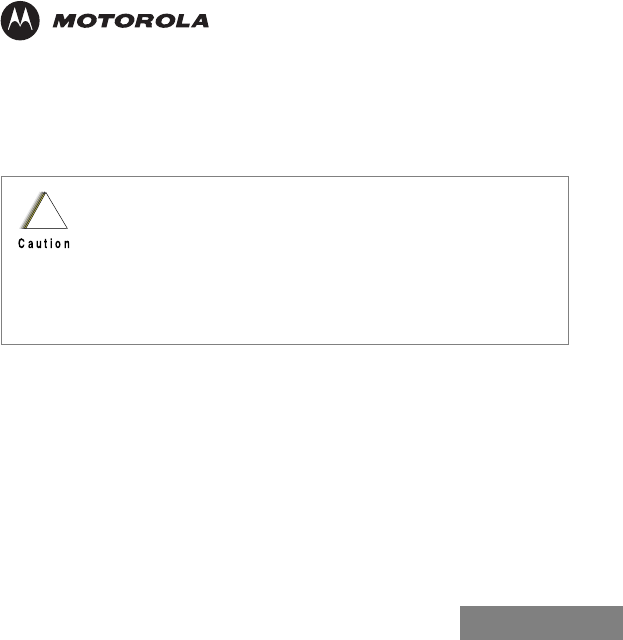Motorola Solutions 89FT4888 PIU AND PIU-XR OF DIOS User Manual Product Safety and RF Exposure Booklet for PIU
Motorola Solutions, Inc. PIU AND PIU-XR OF DIOS Product Safety and RF Exposure Booklet for PIU
Contents
- 1. Users Manual
- 2. Safety Booklet
Safety Booklet

English
Product Safety and RF Energy Exposure Booklet
for Piccolo Interface Units
The Piccolo Interface Unit (PIU) and Piccolo-XR unit are devices which are most
commonly used in fixed installations.
BEFORE USING THIS PIU, READ THIS BOOKLET WHICH
CONTAINS IMPORTANT OPERATING INSTRUCTIONS FOR
SAFE USAGE AND RF ENERGY AWARENESS AND CONTROL
INFORMATION AND OPERATIONAL INSTRUCTIONS FOR
COMPLIANCE WITH RF ENERGY EXPOSURE LIMITS IN
APPLICABLE NATIONAL AND INTERNATIONAL STANDARDS.
ALSO READ THE OPERATIONAL INSTRUCTIONS FOR SAFE
USAGE.
!
Copyright © Motorola 2009
All Rights Reserved
@6802974C70@
6802974C70-P
DIOS_SafetyBooklet-Fixed_Eng.fm Page 1 Thursday, July 23, 2009 1:36 PM

English
DIOS_SafetyBooklet-Fixed_Eng.fm Page 2 Thursday, July 23, 2009 1:36 PM

3English
RF Energy Exposure Awareness and Control Information
and Operational Instructions
NOTICE: The PIU and Piccolo-XR devices are authorized for general
population consumer use.
The PIU and Piccolo-XR use electromagnetic energy in the radio frequency (RF)
spectrum to provide communications between two or more users over a distance.
They use radio frequency (RF) energy or radio waves to send and receive data.
RF energy is one form of electromagnetic energy. Other forms include, but are
not limited to, sunlight and x-rays. RF energy, however, should not be confused
with these other forms of electromagnetic energy, which when used improperly,
can cause biological damage. Very high levels of x-rays, for example, can
damage tissues and genetic material.
Experts in science, engineering, medicine, health, and industry work with
organizations to develop standards for safe exposure to RF energy. These
standards provide recommended levels of RF exposure for both workers and the
general public. These recommended RF exposure levels include substantial
margins of protection.
All Motorola PIUs and Piccolo-XR units are designed, manufactured, and tested
to ensure they meet government-established RF exposure levels. In addition,
manufacturers also recommend specific operating instructions to users of PIUs
and Piccolo-XR units. These instructions are important because they inform
users about RF energy exposure and provide simple procedures on how to
control it.
DIOS_SafetyBooklet-Fixed_Eng.fm Page 3 Thursday, July 23, 2009 1:36 PM

4
English
Please refer to the following websites for more information on what RF energy
exposure is and how to control your exposure to assure compliance with
established RF exposure limits:
http://www.fcc.gov/oet/rfsafety/rf-faqs.html
http://www.osha.gov/SLTC/radiofrequencyradiation/index.html
Federal Communication Commission (FCC) Regulations
The FCC rules require manufacturers to comply with the FCC RF energy
exposure limits for PIUs and Piccolo-XR units before they can be marketed in the
U.S.
Compliance with RF Exposure Standards
Your Motorola PIU and Piccolo-XR are designed and tested to comply with a
number of national and International standards and guidelines (listed below) for
human exposure to radio frequency electromagnetic energy. The PIU and
Piccolo-XR comply with the IEEE (FCC) and ICNIRP exposure limits for
uncontrolled RF exposure environments. In terms of measuring RF energy for
compliance with these exposure guidelines, your PIU and Piccolo-XR generate
measurable RF energy only while they are transmitting, not when they are
receiving or in standby mode.
DIOS_SafetyBooklet-Fixed_Eng.fm Page 4 Thursday, July 23, 2009 1:36 PM

5English
Your Motorola PIU and Piccolo-XR comply with the following RF energy
exposure standards and guidelines:
• United States Federal Communications Commission, Code of Federal
Regulations; 47CFR part 2 sub-part J
• American National Standards Institute (ANSI) / Institute of Electrical and
Electronic Engineers (IEEE) C95. 1-1992
• Institute of Electrical and Electronic Engineers (IEEE) C95.1-1999 Edition
• International Commission on Non-Ionizing Radiation Protection (ICNIRP) 1998
• Ministry of Health (Canada) Safety Code 6. Limits of Human Exposure to
Radiofrequency Electromagnetic Fields in the Frequency Range from 3 kHz to
300 GHz, 1999
• Australian Communications Authority Radiocommunications (Electromagnetic
Radiation – Human Exposure) Standard, 2003
• ANATEL ANNEX to Resolution No. 303 of July 2, 2002 "Regulation of limitation
of exposure to electrical, magnetic and electromagnetic fields in the radio
frequency range between 9 KHz and 300 GHz" and "Attachment to resolution #
303 from July 2, 2002"
DIOS_SafetyBooklet-Fixed_Eng.fm Page 5 Thursday, July 23, 2009 1:36 PM

6
English
RF Exposure Compliance and Control Guidelines and Operating
Instructions
To ensure compliance with the uncontrolled environment exposure limits, always
adhere to the following procedures.
Guidelines
• User awareness instructions should accompany device when transferred to
other users.
• Do not use this device if the operational requirements described herein are not
met.
Operating Instructions
• Transmit only when people are at a minimum distance of 8 inches (20
centimeters) away from the device and its antenna. Keeping the PIU and the
Piccolo-XR at a proper distance is important because RF exposures decrease
with increasing distance from the antenna.
Approved Accessories
• Use only Motorola-approved supplied or replacement antennas, batteries, and
accessories. Use of Non-Motorola approved antennas, batteries, and
accessories may exceed the FCC (IEEE) and ICNIRP RF exposure guidelines.
Additional Information
For additional information on exposure requirements or other training information,
visit http://www.motorola.com/rfhealth.
DIOS_SafetyBooklet-Fixed_Eng.fm Page 6 Thursday, July 23, 2009 1:36 PM

7English
Compliance and Control Guidelines for Two-Way Radios Installed
as Fixed Site Control Stations
As with all fixed site antenna installations, it is the responsibility of the licensee to
manage the site in accordance with applicable regulatory requirements.
Electromagnetic Interference/Compatibility
NOTE: Nearly every electronic device is susceptible to electromagnetic
interference (EMI) if inadequately shielded, designed, or otherwise
configured for electromagnetic compatibility.
Facilities
To avoid electromagnetic interference and/or compatibility conflicts, turn off your
PIU and Piccolo-XR in any facility where posted notices instruct you to do so.
Hospitals or health care facilities may be using equipment that is sensitive to
external RF energy.
DIOS_SafetyBooklet-Fixed_Eng.fm Page 7 Thursday, July 23, 2009 1:36 PM

8
English
Operational Warnings
Potentially Explosive Atmospheres
(Explosive atmospheres refers to hazard classified locations that
may contain hazardous gas, vapors, or dusts.)
Turn off your PIU and Piccolo-XR prior to entering any area with a
potentially explosive atmosphere.
Do not remove, install, or charge batteries in such areas. Sparks in
a potentially explosive atmosphere can cause an explosion or fire
resulting in bodily injury or even death.
The areas with potentially explosive atmospheres referred to
above include fueling areas such as below decks on boats, fuel or
chemical transfer or storage facilities, and areas where the air
contains chemicals or particles such as grain, dust or metal
powders. Areas with potentially explosive atmospheres are often,
but not always, posted.
Blasting Caps and Blasting Areas
To avoid possible interference with blasting operations, turn off
your PIU and Piccolo-XR when you are near electrical blasting
caps, in a blasting area, or in areas posted: "Turn off two-way
radio." Obey all signs and instructions.
!!
!!
DIOS_SafetyBooklet-Fixed_Eng.fm Page 8 Thursday, July 23, 2009 1:36 PM

9English
Operational Cautions
A modification changes the unit’s hardware from its original design configuration.
Modifications can only be made by the original product manufacturer.
Antennas
Do not use any PIU or Piccolo-XR that has a damaged antenna. If a
damaged antenna comes into contact with your skin, a minor burn can
result.
Batteries
All batteries can cause property damage and/or bodily injury, such as
burns, if a conductive material such as jewelry, keys, or beaded chains
touches exposed terminals. The conductive material may complete an
electrical circuit (short circuit) and become quite hot. Exercise care in
handling any charged battery, particularly when placing it inside a
pocket, purse, or other container with metal objects.
!
DIOS_SafetyBooklet-Fixed_Eng.fm Page 9 Thursday, July 23, 2009 1:36 PM

10
English
Notes
DIOS_SafetyBooklet-Fixed_Eng.fm Page 10 Thursday, July 23, 2009 1:36 PM

11 English
Notes
DIOS_SafetyBooklet-Fixed_Eng.fm Page 11 Thursday, July 23, 2009 1:36 PM

English
DIOS_SafetyBooklet-Fixed_Eng.fm Page 12 Thursday, July 23, 2009 1:36 PM